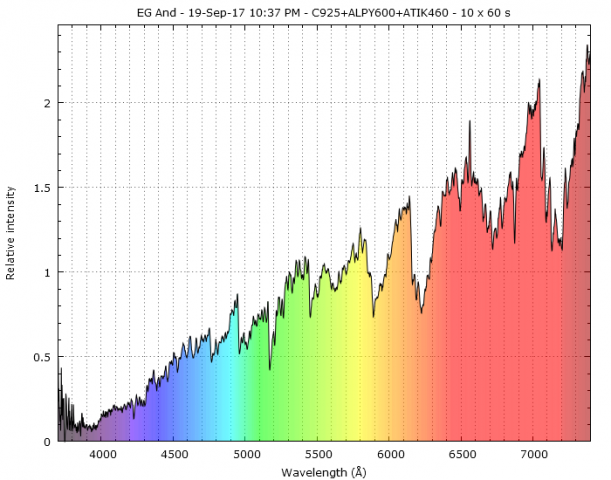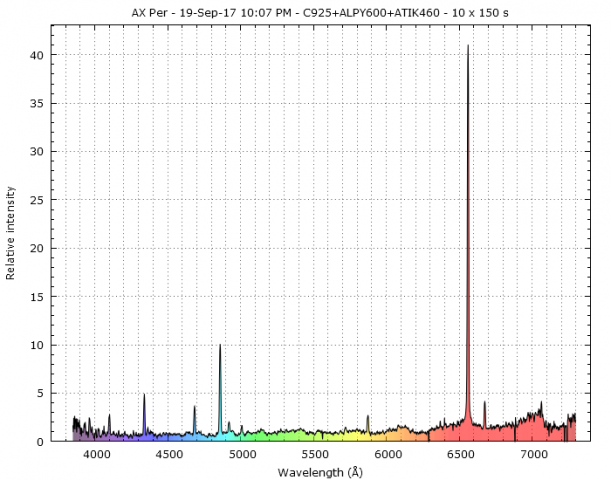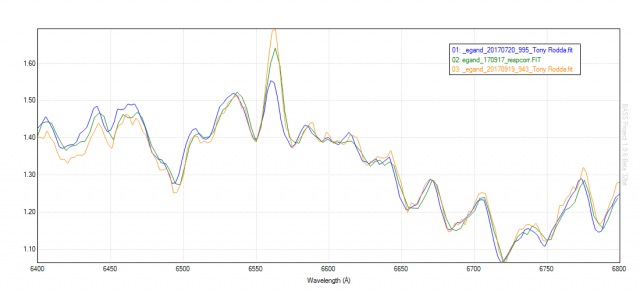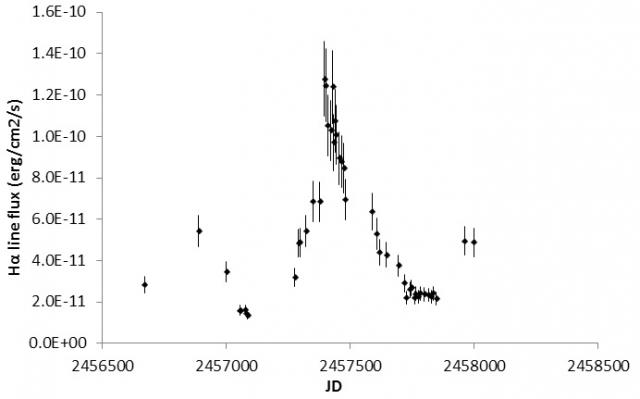› Forums › Spectroscopy › A couple of symbiotics from earlier in the week
- This topic has 4 replies, 3 voices, and was last updated 8 years, 2 months ago by
 David Boyd.
David Boyd.
-
AuthorPosts
-
22 September 2017 at 3:12 pm #573851
 Tony RoddaParticipant
Tony RoddaParticipantEG And and AX per Symbiotic stars.
Both M class stars (M2IIIep and M3IIIep respectively) but look at the difference in emission lines!
Probably my last posting before I tear down the obsy for the new one arriving Tuesday.
Regards
T

 22 September 2017 at 8:17 pm #578574
22 September 2017 at 8:17 pm #578574 Hugh AllenParticipant
Hugh AllenParticipantHi Tony,
Very nice spectra as ever, the emission lines in AX Per are amazingly intense! I noticed from the EG And spectra that we’re both posting in the database that the H-alpha emission is brightening significantly. I downloaded your July 20th and September 19th spectra and added in my September 17th spectrum. There is a nice brightening trend even between 17th and 19th! The database is a great resource. Good luck with your new observatory
Cheers
Hugh
 23 September 2017 at 9:35 am #578575
23 September 2017 at 9:35 am #578575 David BoydParticipant
David BoydParticipantIt is also worth keeping an eye on the H-alpha emission line in AX Per which shows strong orbital modulation, as do all the Balmer lines. The following plot shows my flux measurements over the last two orbital cycles. Coverage of the first cycle was patchy. The phase is currently about 0.4 and the flux is now rising. It will be interesting to see if the peak is as high as last cycle.
Regards,
David
 24 September 2017 at 4:35 pm #578576
24 September 2017 at 4:35 pm #578576 Hugh AllenParticipant
Hugh AllenParticipantThanks David, that’s a very interesting set of data that you have generated on AX Per. It prompted me to think about the timing of the EG And eclipse.
The most recent paper that I could find relating to this was a PhD thesis from 2012 by Joseph Roche at the University of Dublin https://arxiv.org/abs/1210.7699 Based on the table of observations on page 72, especially the observation at phase 0.497 on 31st July 2003, I estimate that the last AG And eclipse occurred around mid-June this year (using the orbital period of 482.6 days from Fekel et al in 2000 http://iopscience.iop.org/article/10.1086/301260/pdf). This fits well with Tony’s spectrum on 20th July 2017 where the Hα emission is just beginning to exceed the adjacent continuum peak at about 6534Å, indicating that the white dwarf is beginning to re-emerge from behind the red giant. It also fits well with J Guarro Flo’s series of spectra from 21st Jan – 24th Feb last year 2016 which show the lowest Hα emission relative to the 6534Å continuum occurring somewhere near 30th Jan 2016 (I estimate that the eclipse would have occurred around mid Feb 2016). The next AG And eclipse should therefore be in early October next year 2018, nicely timed for a regular series of observations at a scociable evening hour in the months surrounding 🙂
Cheers
Hugh
25 September 2017 at 1:38 pm #578577 David BoydParticipant
David BoydParticipantHi Hugh,
There is a more recent paper on EG And by Kenyon & Garcia at http://iopscience.iop.org/article/10.3847/0004-6256/152/1/1/pdf.
Regards,
David
-
AuthorPosts
- You must be logged in to reply to this topic.
